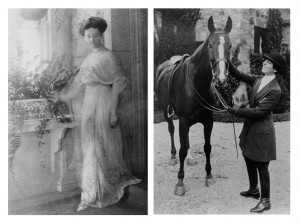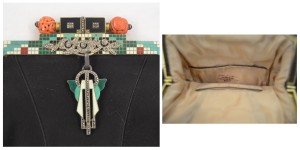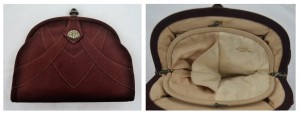Blog post by Samantha Stern, CU class of 2017
These two purses are representative of a very specific lifestyle of the early 1930s. Their owner, Gertrude Heim Remey, was one of the most elite early 20th century socialites living in Washington D.C. Travelling to Paris each year to shop, she enjoyed all of the finer things in life and her apparel and accessories are representative of that excess. While Gertrude’s lifestyle may seem like a fairytale, luxury does not equal happiness and Gertrude suffered from depression, which ultimately led to her death.
Gertrude married Charles Mason Remey, who studied architecture at Cornell (CU class of 1896) and was a great proponent of the Baha’i faith. He was also very prominent in international society. When Gertrude purchased these two purses it was the height of the Great Depression, a time when excess was frowned upon and many struggled to feed their families. These purses are a small part of a much larger collection of Mrs. Remey’s clothing and accessories in the Cornell Costume and Textile Collection (CCTC).
The first purse is a black pocketbook with an intricately enameled frame reminiscent of Arabic mosaic and a coral and enamel clasp with a distinctly oriental flare. The purse itself has two curved seam lines down the front, but most decoration is in the clasp and frame, which is enameled in the cloisonné technique. The inside of the purse has the name “Jane (illegible) artisane, 32 Rue Godot-de-Murdy paris.” The purse also has an enameled interior mirror decorated in the same style.
The second purse is a dark maroon color with very art deco design lines and a marcasite monogram. The closure is a jet cabochon surrounded by marcasite. The simplicity of the purse is representative of its quality. There is not a single skipped stitch or missing stone. The interior of the purse is also quite innovative. It opens to reveal an interior change purse with a “pocket” to separate change. The label reads, “Claire 28 rue Mont Thabor Paris.” The purse also has a strap across the back, making it not just a clutch, but a piece of jewelry.
While purses may seem like a secondary element of a woman’s wardrobe, Mrs. Remey carefully selected purses to represent her status in society. They were wearable art that also served a utilitarian purpose, as they held important elements of her daily life such as money, a makeup compact, a cigarette holder, a lighter, a dance card, and other daily essentials.
Additional items from Mrs. Remey’s wardrobe may be viewed at the CCTC upon request. After Mrs. Remey’s death in 1932, her husband, Charles, donated much of her wardrobe including jewelry, purses, evening gowns, leisure wear, sportswear, lingerie, shoes, and much more in memory of his wife.
Samantha Stern (CU class of 2017) is an undergraduate research assistant in the Cornell Costume and Textile Collection majoring in Fiber Science and Apparel Design (with a concentration in Fashion Design). She has collected and found inspiration in vintage clothing and accessories for as long as she can remember.





